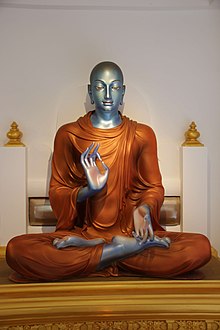
Back مودجالايانا Arabic Маудгаляяна Bulgarian ဗွေႏမဟာႏမောဂ္ဂလန်ႏ BLK মৌদ্গল্যায়ন Bengali/Bangla མོའུ་འགལ་བུ། Tibetan Maudgalyayana Catalan Maudgaljájana Czech Moggalana German Maŭdgaljajano Esperanto Maudgalyayana Spanish
Maudgalyayana | |
|---|---|
 Statue of Moggallana, depicting his dark skin color (blue, black). | |
| Title | Foremost disciple, left hand side chief disciple of Gautama Buddha; second chief disciple of Gautama Buddha |
| Personal | |
| Born | year unknown |
| Died | before the Buddha's parinibbana Kālasilā Cave, Magadha |
| Religion | Buddhism |
| Parent(s) | Mother: Moggalī, father: name unknown |
| School | all |
| Senior posting | |
| Teacher | Gautama Buddha |
Students
| |
| Translations of Maudgalyayana | |
|---|---|
| Sanskrit | Maudgalyāyana Sthavira |
| Pali | Moggallāna Thera |
| Burmese | ရှင်မဟာမောဂ္ဂလာန် (MLCTS: ʃɪ̀ɴməhàmaʊʔɡəlàɴ) |
| Chinese | 目連/摩诃目犍乾连 (Pinyin: Mùlián/Móhēmùjiānqiánlián) |
| Japanese | 目犍連 (Rōmaji: Mokuren/Mokkenren) |
| Khmer | ព្រះមោគ្គលាន (UNGEGN: Preah Mokkealean) |
| Korean | 摩訶目犍連/目連 (RR: Mongryŏn/Mokkŏllyŏn) |
| Mongolian | Molun Toyin |
| Sinhala | මහමුගලන් මහ රහතන් වහන්සේ |
| Tibetan | མོའུ་འགལ་གྱི་བུ་ (Mo'u 'gal gy i bu chen po) |
| Tamil | முகிலண்ணர் (Mukilannar) |
| Thai | พระโมคคัลลานะ (RTGS: Phra Mokkhanlana) |
| Vietnamese | Mục-kiền-liên |
| Glossary of Buddhism | |
Maudgalyāyana (Pali: Moggallāna), also known as Mahāmaudgalyāyana or by his birth name Kolita, was one of the Buddha's closest disciples. Described as a contemporary of disciples such as Subhuti, Śāriputra (Pali: Sāriputta), and Mahākāśyapa (Pali: Mahākassapa), he is considered the second of the Buddha's two foremost male disciples, together with Śāriputra. Traditional accounts relate that Maudgalyāyana and Śāriputra become spiritual wanderers in their youth. After having searched for spiritual truth for a while, they come into contact with the Buddhist teaching through verses that have become widely known in the Buddhist world. Eventually they meet the Buddha himself and ordain as monks under him. Maudgalyāyana attains enlightenment shortly after that.
Maudgalyayana and Śāriputra have a deep spiritual friendship. They are depicted in Buddhist art as the two disciples that accompany the Buddha, and they have complementing roles as teachers. As a teacher, Maudgalyayana is known for his psychic powers, and he is often depicted using these in his teaching methods. In many early Buddhist canons, Maudgalyāyana is instrumental in re-uniting the monastic community after Devadatta causes a schism. Furthermore, Maudgalyāyana is connected with accounts about the making of the first Buddha image. Maudgalyāyana dies at the age of eighty-four, killed through the efforts of a rival sect. This violent death is described in Buddhist scriptures as a result of Maudgalyāyana's karma of having killed his own parents in a previous life.
Through post-canonical texts, Maudgalyāyana became known for his filial piety through a popular account of him transferring his merits to his mother. This led to a tradition in many Buddhist countries known as the ghost festival, during which people dedicate their merits to their ancestors. Maudgalyāyana has also traditionally been associated with meditation and sometimes Abhidharma texts, as well as the Dharmaguptaka school. In the nineteenth century, relics were found attributed to him, which have been widely venerated. His female counterpart was Utpalavarṇā (Pali: Uppalavaṇṇā).
© MMXXIII Rich X Search. We shall prevail. All rights reserved. Rich X Search